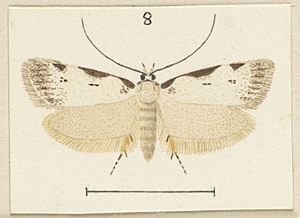Izatha balanophora facts for kids
Quick facts for kids Izatha balanophora |
|
|---|---|
 |
|
| Scientific classification | |
| Kingdom: | |
| Phylum: | |
| Class: | |
| Order: | |
| Family: |
Oecophoridae
|
| Genus: | |
| Species: |
I. balanophora
|
| Binomial name | |
| Izatha balanophora (Meyrick, 1897)
|
|
| Synonyms | |
|
|
Izatha balanophora is a type of moth that belongs to the Oecophoridae family. It lives only in New Zealand, and you can find it all over the North Island. These moths are special because their young, called larvae, eat the dead bark of kānuka trees. Adult moths fly around from December to March.
Contents
Discovering and Naming the Moth
This moth was first described by a scientist named Edward Meyrick in 1897. He used a moth specimen found by George Hudson in Wellington, New Zealand. Meyrick first named it Semiocosma balanophora. The original moth specimen he used is kept safe at the Natural History Museum, London.
Later, in 1927, another scientist, Alfred Philpott, thought he had found a new type of moth. He named it Izatha milligani. However, it turned out to be the same moth! George Hudson realized this in 1939 and corrected the name. Now, we know it as Izatha balanophora. The specimen Philpott used is now at the New Zealand Arthropod Collection.
What Does the Moth Look Like?
Male Izatha balanophora moths have a wingspan of about 19.5 to 27 millimeters (which is less than an inch). Female moths are a bit larger, with wingspans from 23.5 to 31 millimeters.
These moths are mostly white with some dark brown or black scales. They have dark marks along the edges of their front wings. Sometimes, they can be confused with other similar moths like I. blepharidota or I. mesoschista. However, I. balanophora usually has a wider dark patch on its front wing. It also doesn't have a curved black line on its front wing that some other similar moths do.
Where Does the Moth Live?
This moth is found only in New Zealand. It is widespread across the North Island, meaning it can be found in many different areas there. However, it's not very common to see.
Scientists have recorded Izatha balanophora in several places. These include Northland, Auckland, Waikato, Taranaki, Taupo, Rangitikei, and Wellington districts. While some old records suggested it might live in the South Island, scientists now think those were likely a different type of moth called I. manubriata.
Life and Habitat
Adult Izatha balanophora moths are active and can be seen flying from December to March. They sometimes fly towards lights at night.
The young moths, called larvae, have a unique diet. They have been found living and feeding on the dead wood of kānuka trees. They also eat wood from other rotting logs found on the ground. This shows they play a role in breaking down dead plant material in their environment.

